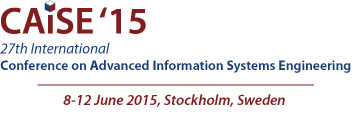RW-BPMS 2015 – 1st Workshop on Real-World Objects in Business Process Management Systems
https://ai.wu.ac.at/r
The increased availability of sensors disseminated in the world has lead to the possibility to monitor in detail the evolution of several real-world objects of interest. GPS receivers, RFID chips, transponders, detectors, cameras, satellites, etc. concur in the depiction of the current status of monitored things. Therefore, the opportunity arose to connect physical reality to digital information. The screening of real-world objects makes indeed sensors the interface towards real-world information, as they are the originators of machine-readable events. The exploitation of such knowledge is leading to successful applications such as Smart Cities, Flight Monitoring, Pollution Control, Internet of Things, and Dynamic Manufacturing Networks.
The amount of information at hand would consent a fine-grained monitoring, mining, and decision support for business processes, stemming from the joint observation of business-related objects in real world. However, the main focus of process and data analysis in Business Process Management (BPM) still lies at a high level of abstraction, such as activities’ status, and is based on digital-to-digital information, such as information systems’ data- and activity-centric logs. Furthermore, a limited investigation from the BPM community has been evinced towards the physical-to-digital bridge so far. Such bridge would be naturally provided by rethought information systems, where the knowledge extracted from real-world objects would best depict the contingencies and the context in which business processes are carried out. At the same time, awareness of physical reality for undertaken actions would allow for a better control over the interaction that the Business Process Management Systems has with the real world.
The objective of the RW-BPMS workshop is therefore to attract novel research and industry approaches investigating the connection of business processes with real-world objects monitoring. Conceptual, technical and application-oriented contributions are pursued within the scope of this theme.
Topics of Interest
Relevant topics include, but are not limited to:
(1) Real-world objects in decision making, support and process mining
- Execution/deployment challenges for BPs that include sensors
- Using real-world objects monitoring for business process execution and control
- Integration of data from real-world objects in BPM applications
- Process control based on real-world objects
- Mixed physical-digital events correlation and aggregation
- Mining mixed physical-digital events
- Continuous mining of real-world events for running processes
- Case identification from sensor data
- Event log extraction from sensor data
(2) Real-world objects in business process modeling
- Modeling challenges to combine static information of business process execution and continuously updated information of real-world objects
- Support for decision making based on sensor data for the business process execution
- Requirement analysis for integrating real-world objects monitoring with business process monitoring
- Opportunities of modeling sensor data in business process models
- Inclusion of real-world information for the visualization of current process status
- Novel visual representations for mixed physical-digital evolution of processes
- Modeling flexibility for business process management involving real-world object interactions
- Real-world objects status compliance to the business model
- Compliance of the business model to the status evolution of real-world objects
- Defining constraints on real-world objects in business process modeling
(3) Process adaptivity and prediction based on real-world objects
- Opportunities of mining sensor data to model business processes
- Opportunities of mining sensor data to control the execution of business processes
- Monitoring real-world objects to predict business process execution (e.g. duration of tasks)
- Mixed physical-digital data aggregation in event analysis
- Real-world-event driven process adaptation
- Studies on the effects of process enactments on real world
(4) General view on real-world objects in BPMS
- Empirical research on the integration of real-world objects in BPMS
- Case studies on the integration of real-world objects in BPMS
- Best practice for the integration of real-world objects in BPMS
- Vision papers on the integration of real-world objects in BPMS
Submission Guidelines
Prospective authors are invited to submit papers in any of the topics of the workshop. Papers must be written in English as full research paper (max. 12 pages) or short paper (position paper, work in progress; max. 6 pages). Papers must contain original contributions that have not been published previously, nor already submitted to other conferences or journals in parallel with this workshop. Each submission is reviewed by at least three experts in this field.
Submitted papers must follow the Lecture Notes in Business Information Processing (LNBIP) guidelines. Papers should be submitted electronically as a self-contained PDF file using the following submission website: https://easychair.org
Important Dates
Submission: 13th February 2015- Extended submission deadline: 2nd March 2015
- Notification: 13th March 2015
- Camera-ready version: 20th March 2015
Workshop Chairs
- Claudio Di Ciccio (Vienna University of Economics and Business, Austria)
- Anne Baumgraß (Hasso Plattner Institute at the University of Potsdam)
- Remco Dijkman (Eindhoven University of Technology, The Netherlands)





